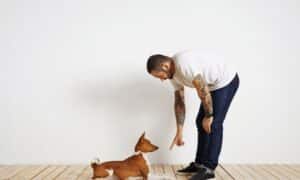“This post contains affiliate links, and I will be compensated if you make a purchase after clicking on my links.”
Owning a dog means more than simply providing shelter, food and water. When I was training dogs for my dad I relied on his experience, plus read many basic knowledge for dog training books learning as much as I could. This knowledge really made a difference in the ensuring years with the many different breeds I have owned. It will for you as well, so knowing a few basic dog training tips is what we will cover today.
Basic knowledge for dog training
Learning a bit of basic knowledge for dog training is something all dog owners need to know if they want a dog that listens to commands, is properly socialized, and is a joy to own. Without any basic training you are basically letting an animal run wild through you and your families lives and this is not a good thing.
Training should begin as soon as you bring the puppy home. Puppies have a very short attention span so begin with very simple training such as the commands of “their name, no, good boy and out” for going outside to do their business. Keep these initial behavior commands to one short word or two, as the puppy will learn faster than if you use a complicated series of commands. This level of training comes later after the pup has reached 12 months old, and is physically as well as mentally developed to where they will understand and accept more intensive training.
Some of the basics includes learning to instruct the dog in a clear, friendly, and distinctive voice so as not to confuse the pup. Any slight variation of basic commands is going to confuse the dog so always use the same command for what behavior you are teaching. Make sure all members of your family understand this concept and do accordingly.
Never scream or shout at the dog and absolutely do not strike the puppy for failing to respond as you wish. Along with positive rewards, be sure you use “constructive discipline”. An excellent description of this is given in an Animal Planet website article:
Examples of constructive discipline may include time outs (removal), sounds to interrupt behavior and refocus the dog onto something more positive, or ignoring inappropriate behavior (such as jumping up), so that the behavior is not reinforced and eventually goes into extinction.
Remember, they are just like a human baby and have to learn over time. You want the puppy to become eager when it is being given commands. An eager puppy that receives plenty of praise and a tasty treat is going to want to learn, while an abused puppy will fear you and the commands.
Your basic knowledge for dog training will include house breaking the puppy. Be very patient, and never scold the dog for making a mess unless you actually catch them doing so. You will probably want a crate for this stage of your new family members training.
Do you train your dog? Comments are welcome below.


















